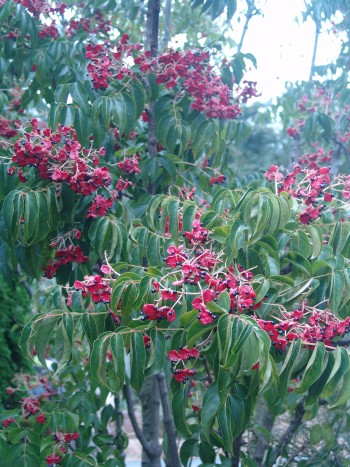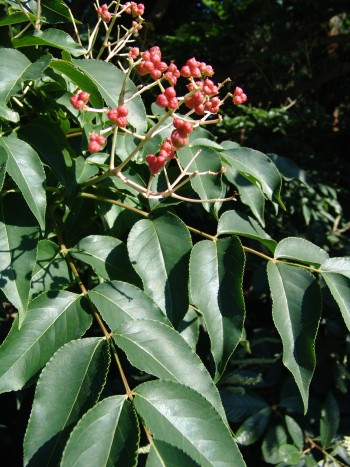Euscaphis japonica
In 1985, the world renowned plantsman, JC Raulston travelled to Korea on a collecting trip sponsored by the United States National Arboretum. Among the hundreds of seeds that were collected was a seed of the Korean sweetheart tree, Euscaphis japonica.
In 1993 the Scott Arboretum received a package of plants from JC Raulston of the North Carolina State University Arboretum (today know as the JC Raulston Arboretum.) One of the small plants in that box was a seedling of Euscaphis japonica. We grew the plant in our growing area until 1998 when it reached sufficient size to be planted at the south end of Beardsley Hall.
Today, this small ornamental tree is about fifteen feet tall with an eight-foot spread. The grey colored bark has white striations which give it some winter interest. The leaves are pinnately compound which give it an interesting textural quality. But the fruits are really why you would grow this plant. In late summer the clusters of heart-shaped fruits ripen. They transform from green to pink to red. In early to mid-October they split open revealing a tiny, shiny, black seed. The seeds don’t immediately fall out but sit within the red seed cases adding to the ornamental look of the plant.
This tough tree can grow in a variety of soils, but will thrive and fruit best in full sun.
This tree is still relatively unknown in American gardens, however, there are some nurserymen who have collected seeds. Perhaps, it is just a matter of time before this becomes a popular ornamental tree.







joel adler
Posted at 07:50h, 17 FebruaryWhere is it possible to obtain one?
Andrew Bunting
Posted at 17:08h, 22 FebruaryI rarely see Euscaphis japonica available, but you might want to try Camellia Forest Nursery which is mail order.
Andrew Bunting, Curator
Eileen
Posted at 23:05h, 06 MarchKIRKPATRICK NURSERIES
GLEN MILLS PA has Euschapis japonica in production
Steve
Posted at 03:02h, 07 MayHey there – I got a lot of seed from B&T World Seeds but I have to say I have no idea how to get it to germinate. I sowed them in late Feb – some in heat (20C) and some on the bench to get chilled. Nothing so far. I might unearth some to see if anything’s happening. If you have any further hints I’d be grateful. It’ is a terrrific tree, almost never seen over here in the UK.
Andrew Bunting
Posted at 09:09h, 07 MayI would suspect that to germinate Euscaphis japonica that it might need a cold period in the fall/winter. I have not grown this plant myself from seed, but I believe seed is the only viable option for propagation.
Andrew Bunting, Curator
Jim
Posted at 22:26h, 04 JuneDo you have any idea if this plant will grow in the humid coastal south? (i.e., Baton Rouge, Louisiana, zone 8b) Thanks!
Rhoda
Posted at 10:05h, 06 JuneEuscaphis japonica is rated for zones 6-9. So I would definitely try this! Good luck!
Jim
Posted at 16:37h, 28 OctoberA Euscaphis japonica I gave to friends here in Portland (USDA Zone 7) has been thriving on the south wall of their house for almost a decade, surviving cold down into the teens without any visible damage. The reddish-pink flower clusters are quite showy this time of year. This specimen is now about 10 feet tall and seems healthy and vigorous. I have never seen it offered by local nurseries in Oregon, so it remains hard to come by.
Steve
Posted at 03:34h, 13 OctoberAh – how funny – I see I asked about germination a while back on this very blog. The B&T seeds (a huge number – a 2 x 4 zip lock, completely stuffed) in their various pots have suffered the vagaries of the UK climate with minimal protection and I’m pleased to say I’ve had a fair few germinations since then. They seem very sporadic, but the remaining seeds have been left in to suffer a bit more. The very shiny seed coat gradually erodes over time, which is probably a good sign. The seedlings i have though are behaving oddly. They seem reluctant to form a good root system and the resulting foliage is quite chlorotic. Some deficiency or other. The post says the trees are happy on a variety of soils so I’m open to suggestions on how to get them growing vigorously.